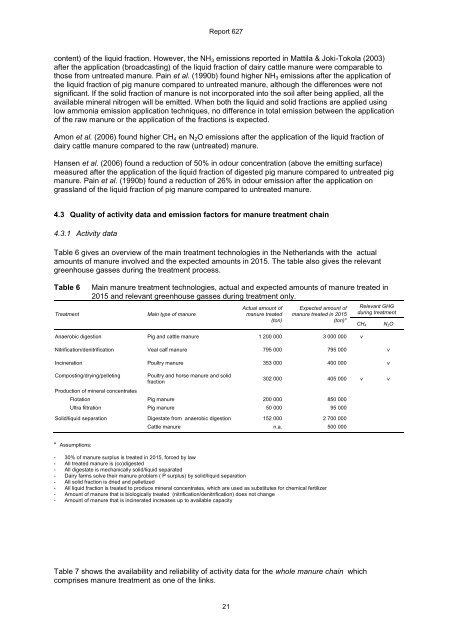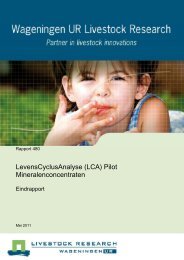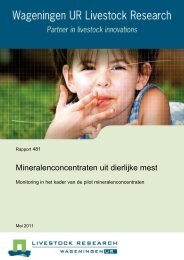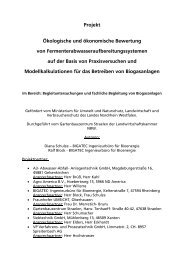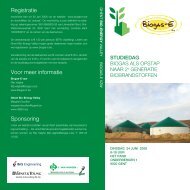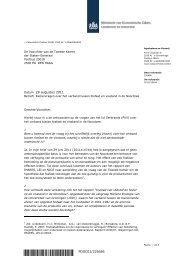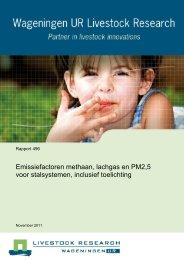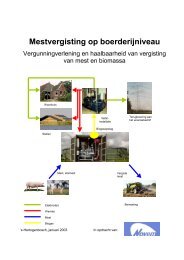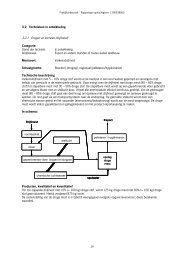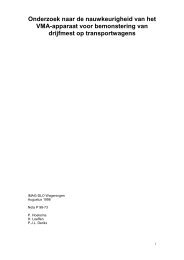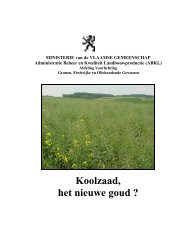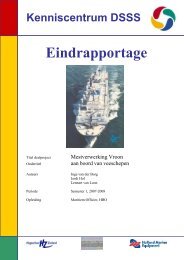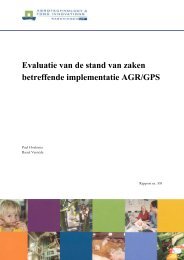Monitoring methane and nitrous oxide reduction by manure treatment
Monitoring methane and nitrous oxide reduction by manure treatment
Monitoring methane and nitrous oxide reduction by manure treatment
You also want an ePaper? Increase the reach of your titles
YUMPU automatically turns print PDFs into web optimized ePapers that Google loves.
Report 627<br />
content) of the liquid fraction. However, the NH3 emissions reported in Mattila & Joki-Tokola (2003)<br />
after the application (broadcasting) of the liquid fraction of dairy cattle <strong>manure</strong> were comparable to<br />
those from untreated <strong>manure</strong>. Pain et al. (1990b) found higher NH3 emissions after the application of<br />
the liquid fraction of pig <strong>manure</strong> compared to untreated <strong>manure</strong>, although the differences were not<br />
significant. If the solid fraction of <strong>manure</strong> is not incorporated into the soil after being applied, all the<br />
available mineral nitrogen will be emitted. When both the liquid <strong>and</strong> solid fractions are applied using<br />
low ammonia emission application techniques, no difference in total emission between the application<br />
of the raw <strong>manure</strong> or the application of the fractions is expected.<br />
Amon et al. (2006) found higher CH4 en N2O emissions after the application of the liquid fraction of<br />
dairy cattle <strong>manure</strong> compared to the raw (untreated) <strong>manure</strong>.<br />
Hansen et al. (2006) found a <strong>reduction</strong> of 50% in odour concentration (above the emitting surface)<br />
measured after the application of the liquid fraction of digested pig <strong>manure</strong> compared to untreated pig<br />
<strong>manure</strong>. Pain et al. (1990b) found a <strong>reduction</strong> of 26% in odour emission after the application on<br />
grassl<strong>and</strong> of the liquid fraction of pig <strong>manure</strong> compared to untreated <strong>manure</strong>.<br />
4.3 Quality of activity data <strong>and</strong> emission factors for <strong>manure</strong> <strong>treatment</strong> chain<br />
4.3.1 Activity data<br />
Table 6 gives an overview of the main <strong>treatment</strong> technologies in the Netherl<strong>and</strong>s with the actual<br />
amounts of <strong>manure</strong> involved <strong>and</strong> the expected amounts in 2015. The table also gives the relevant<br />
greenhouse gasses during the <strong>treatment</strong> process.<br />
Table 6 Main <strong>manure</strong> <strong>treatment</strong> technologies, actual <strong>and</strong> expected amounts of <strong>manure</strong> treated in<br />
2015 <strong>and</strong> relevant greenhouse gasses during <strong>treatment</strong> only.<br />
Treatment Main type of <strong>manure</strong><br />
21<br />
Actual amount of<br />
<strong>manure</strong> treated<br />
(ton)<br />
Expected amount of<br />
<strong>manure</strong> treated in 2015<br />
(ton)*<br />
Anaerobic digestion Pig <strong>and</strong> cattle <strong>manure</strong> 1 200 000 3 000 000 v<br />
Relevant GHG<br />
during <strong>treatment</strong><br />
Nitrification/denitrification Veal calf <strong>manure</strong> 795 000 795 000 v<br />
Incineration Poultry <strong>manure</strong> 353 000 400 000 v<br />
Composting/drying/pelleting<br />
Production of mineral concentrates<br />
Flotation<br />
Ultra filtration<br />
Solid/liquid separation<br />
* Assumptions:<br />
Poultry <strong>and</strong> horse <strong>manure</strong> <strong>and</strong> solid<br />
fraction<br />
Pig <strong>manure</strong><br />
Pig <strong>manure</strong><br />
Digestate from anaerobic digestion<br />
Cattle <strong>manure</strong><br />
CH4<br />
302 000 405 000 v<br />
200 000<br />
50 000<br />
152 000<br />
- 30% of <strong>manure</strong> surplus is treated in 2015, forced <strong>by</strong> law<br />
- All treated <strong>manure</strong> is (co)digested<br />
- All digestate is mechanically solid/liquid separated<br />
- Dairy farms solve their <strong>manure</strong> problem ( P surplus) <strong>by</strong> solid/liquid separation<br />
- All solid fraction is dried <strong>and</strong> pelletized<br />
- All liquid fraction is treated to produce mineral concentrates, which are used as substitutes for chemical fertilizer<br />
- Amount of <strong>manure</strong> that is biologically treated (nitrification/denitrification) does not change<br />
- Amount of <strong>manure</strong> that is incinerated increases up to available capacity<br />
n.a.<br />
850 000<br />
95 000<br />
2 700 000<br />
500 000<br />
Table 7 shows the availability <strong>and</strong> reliability of activity data for the whole <strong>manure</strong> chain which<br />
comprises <strong>manure</strong> <strong>treatment</strong> as one of the links.<br />
N2O<br />
v


